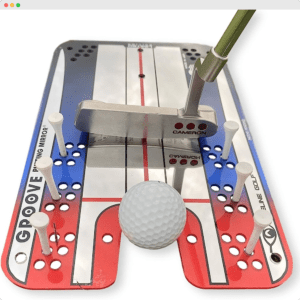Putting is one of the most critical aspects of the game of golf. Whether you’re a beginner or a seasoned pro, having a solid putting game can make all the difference in your overall score. In this article, we will explore the importance of putting and how it can significantly impact your performance on the golf course. Let’s dive in!
1. Proper Grip and Stance

Improving putting skills can have a significant impact on a golfer’s overall game. It can lead to more accurate and consistent putts, resulting in lower scores. Two essential elements for successful putting are the proper grip and stance.
Benefits of improving putting skills
- More accurate and consistent putts
- Lower scores
- Enhanced confidence on the green
Correct grip for putting
The correct grip for putting is a slightly different variation from the full swing grip. The golfer should maintain a light grip pressure and position the hands more in front of the clubface. This grip promotes a smooth and controlled stroke for better accuracy.
Optimal stance for putting
The optimal stance for putting involves a slightly open stance, with the feet shoulder-width apart. The weight should be evenly distributed on both feet, and the golfer should feel balanced and comfortable. This stance allows for a smooth pendulum-like stroke and helps maintain stability throughout the putt.
2. Alignment and Visualization

Aligning the putter face and body
The proper alignment is crucial for a successful putt. Here are some important points to consider:
Correct alignment for a straight putt
– Position your feet parallel to the target line.
– Align your putter face perpendicular to the target line.-
Keep your body aligned with the target line.
Factors that affect alignment and how to adjust for them
– Sloping greens: Adjust your alignment to account for the slope.
– Wind: Consider the wind direction and adjust your alignment accordingly.
Visualizing the putt before taking the stroke
– Imagine the path of the ball rolling into the hole
.- Visualize the speed and break of the putt.
– Use your imagination to improve your putting accuracy.
3. Distance Control
Developing a consistent pace
When it comes to distance control in golf, developing a consistent pace is key. By practicing your swing with different clubs and paying attention to the distance each shot travels, you can get a better sense of how hard to swing for different yardages. Consistency in your swing tempo will help you achieve more accurate distance control.
Using feel and touch for distance control
In addition to developing a consistent pace, using feel and touch can also improve your distance control. By practicing different shots and paying attention to how the ball feels coming off the clubface, you can develop a better sense of how much power to put into each swing. This can be especially useful for shots that require finesse and precision, such as delicate chip shots or putting.
Here are some tips for improving distance control while putting in golf:
- Practice lag putting frequently. Work on hitting putts of various lengths and focusing on getting them to stop near the hole. Don’t worry about holing them. Gauge distance through feel and reading the green.
- Pay attention to how hard you are hitting putts during practice and rounds. Note any tendencies to hit putts too firmly or leave them short.
- On longer putts, think more about the path of the putt and hitting your line. Don’t decelerate or guide the putt.
- Develop a consistent, smooth stroke and follow through. This will help normalize your pace and distance control. Don’t jab at the ball.
- On breaking putts, account for the break by visualizing the path you want the ball to travel on. Hit the putt on your intended initial line.
- If you consistently leave putts short, practice longer follow throughs and accelerate through impact. If you hit putts past the hole, focus on a more controlled stroke.
- Know your own range for hitting putts firmly to hole out. For example, 6 feet and in may be your reliable range to avoid leaving shots short.
- Use uphill and downhill putts during practice to work on factoring slope into distance control.
- Believe in your reads and commit fully to your stroke. Don’t decelerate or second-guess yourself over the ball.
Proper pace and distance control takes practice. Work on lag putting and vary lengths during practice sessions. Develop feel for how far the ball rolls on greens. Stay committed on each putt.

4. Reading Greens
When it comes to putting, understanding the slopes and breaks of the green is crucial for success. Here are some key points to consider:
Understanding slopes and breaks:
- Pay attention to the overall slope of the green, as this will affect the direction and speed of your putt.
- Look for any visible breaks or contours on the green that may impact the path of your putt.
Identifying grain and other factors:
- Grain refers to the pattern in which the grass grows on the green. It can affect the speed and direction of your putt, so be sure to take it into account.
- Other factors to consider include wind, moisture, and the type of grass on the green. Each can have an impact on your putt.
By developing a keen eye for reading greens, you’ll improve your putting game and lower your scores on the golf course.

5. Practice Drills
To improve your golf game, it’s important to incorporate regular practice drills. Here are some drills specifically designed to help you improve your putting accuracy and distance control/consistency:
Drills for improving putting accuracy:
– Gate Drill- Coin Drill- Clock Drill
Drills for distance control and consistency:
– Lag Putting Drill- Tempo Drill- Alignment Stick Drill
6. Mental Game
Managing to put pressure and nerves
Managing putting pressure and nerves is crucial to perform well in golf. Here are some tips to help you stay calm and focused:
- Practice deep breathing exercises to relax your body and mind before putting.
- Visualize successful putts and positive outcomes to build confidence.
- Use positive self-talk to boost your mindset and reduce stress.
Developing a pre-putt routine
Having a consistent pre-putt routine can improve your focus and consistency on the greens. Consider the following elements when developing your routine:
- Analyze the slope and speed of the putt
- Take a few practice strokes to get a feel for the distance
- Align your body and putter with the desired target line
Establishing a routine will help you create a sense of familiarity and confidence when standing over the ball.
7. Using Putting Aids
Putting aids are valuable tools that can help improve your putting skills and increase consistency on the greens. By incorporating putting aids into your practice routine, you can develop a more reliable stroke and enhance your overall performance on the golf course. In this section, we will explore different types of putting aids and how to effectively use them to improve your putting game.
Conclusion
In conclusion, this blog provided a comprehensive guide to improving putting skills in golf. The tips and techniques discussed throughout the article can help golfers of all skill levels enhance their putting game. By focusing on alignment, grip, posture, and practicing regularly, golfers can see significant improvements in their putting accuracy. Remember to stay patient, stay confident, and have fun on the golf course!
Frequently Asked Questions
Q: What is the most important fundamental to focus on for better putting?
A: Having a consistent and solid stroke path and face angle at impact. This requires keeping your eyes over the ball, accelerating through the putt, and keeping the face square.
Q: What type of putter is best for improving my putting skills?
A: The right putter depends on your stroke and preferences. Mallet putters offer more stability while blade putters allow for more feel and control. Testing different putter styles can help determine what works best for your stroke.
Q: How often should I practice putting to see significant improvement?
A: Ideally, you should practice putting for at least 15-30 minutes every time you play or practice at the range. Consistency is key, so putting daily for shorter sessions can be very beneficial.
Q: What drills can I do at home without a putting green to improve my skills?
A: Useful at-home drills include putting towards a target on the carpet, sinking putts into a cup or hole cut in a piece of plywood, and stroking putts along a ruler or board to improve your straightness and path.
Q: Should I change my putting grip or stance to improve my consistency?
A: Only make major changes like altering your grip or stance if your current method is very uncomfortable or unstable. Small tweaks can help, but dramatic changes may do more harm than good. Focus more on your stroke path first.
Q: What is the best way to read greens more accurately when putting?
A: Take time to study the entire green before putting to get a feel for any breaks and slopes. Use your experience and visual cues to read greens. Ask your playing partners how they are reading it as well. The more you practice, the better you will get at green reading.

I’m Donna Weiss, and I am the proud writer behind the captivating content you’ll find on golfneedy.com. As an avid golfer and passionate writer, I have combined my two greatest passions to bring you an incredible golfing experience. Through my articles, I aim to provide you with valuable insights, equipment reviews, and updates on the latest tournaments. Whether you’re a seasoned golfer or just starting out on this exciting journey, I am here to guide you and share my expertise. Together, let’s explore the fascinating world of golf, uncovering new techniques, and enhancing our skills. Join me on this thrilling adventure as we elevate our game and embark on an exciting golfing journey. Read More



